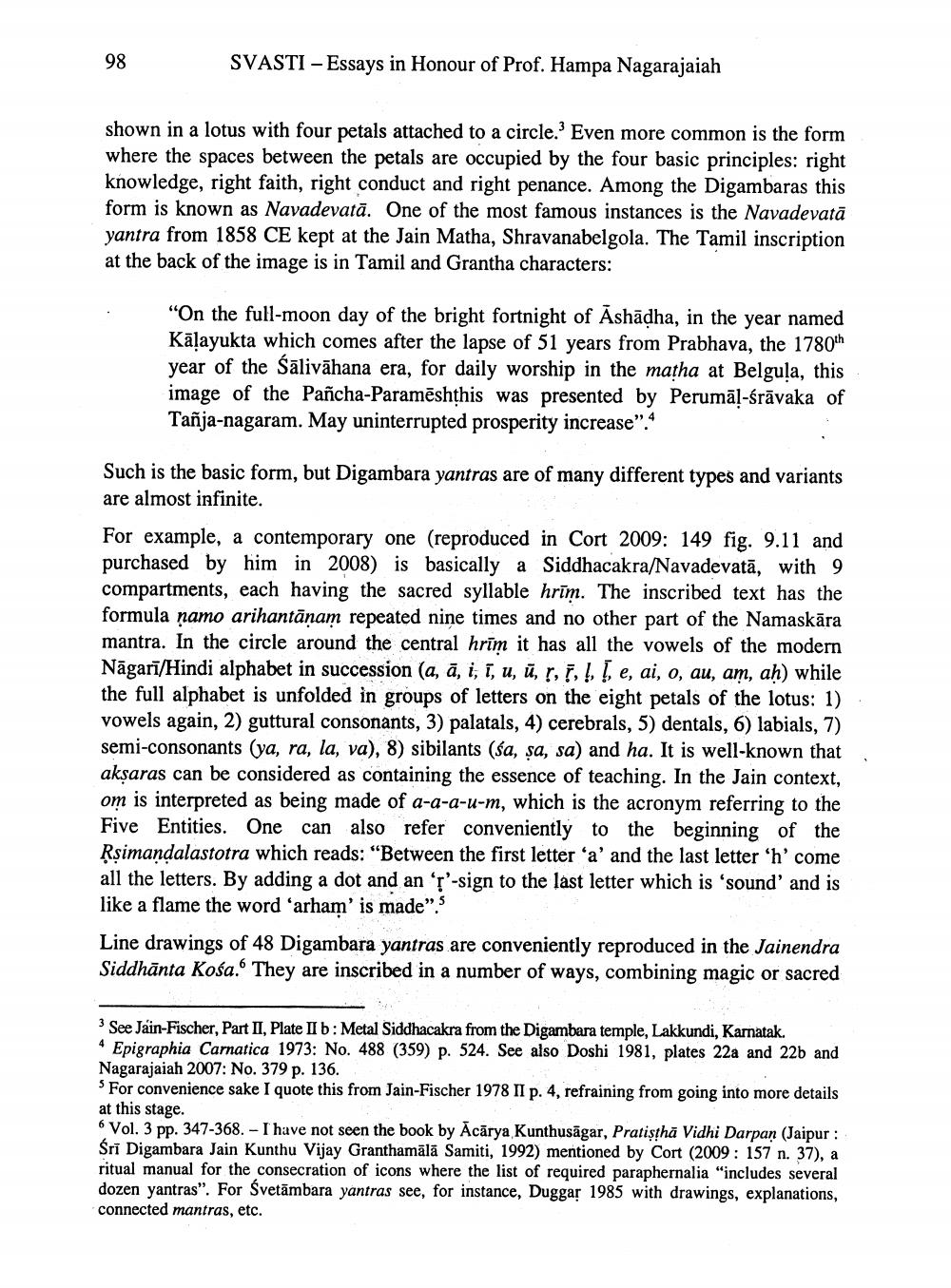________________
SVASTI – Essays in Honour of Prof. Hampa Nagarajaiah
shown in a lotus with four petals attached to a circle. Even more common is the form where the spaces between the petals are occupied by the four basic principles: right knowledge, right faith, right conduct and right penance. Among the Digambaras this form is known as Navadevatā. One of the most famous instances is the Navadevatā yantra from 1858 CE kept at the Jain Matha, Shravanabelgola. The Tamil inscription at the back of the image is in Tamil and Grantha characters:
“On the full-moon day of the bright fortnight of Ashādha, in the year named Kālayukta which comes after the lapse of 51 years from Prabhava, the 1780ch year of the Sālivāhana era, for daily worship in the matha at Belgula, this image of the Pañcha-Paramēshthis was presented by Perumā!-śrāvaka of Tañja-nagaram. May uninterrupted prosperity increase".
Such is the basic form, but Digambara yantras are of many different types and variants are almost infinite. For example, a contemporary one (reproduced in Cort 2009: 149 fig. 9.11 and purchased by him in 2008) is basically a Siddhacakra/Navadevatā, with 9 compartments, each having the sacred syllable hrīm. The inscribed text has the formula ņamo arihantānam repeated nine times and no other part of the Namaskāra mantra. In the circle around the central hrīm it has all the vowels of the modern Nāgarī/Hindi alphabet in succession (a, ā, i, ī, u, ū, ļ, 7,!,!, e, ai, o, au, am, ah) while the full alphabet is unfolded in groups of letters on the eight petals of the lotus: 1) vowels again, 2) guttural consonants, 3) palatals, 4) cerebrals, 5) dentals, 6) labials, 7) semi-consonants (ya, ra, la, va), 8) sibilants (ša, șa, sa) and ha. It is well-known that aksaras can be considered as containing the essence of teaching. In the Jain context, om is interpreted as being made of a-a-a-u-m, which is the acronym referring to the Five Entities. One can also refer conveniently to the beginning of the Rsimandalastotra which reads: "Between the first letter 'a' and the last letter 'h' come all the letters. By adding a dot and an ‘-sign to the last letter which is 'sound' and is like a flame the word ‘arham' is made". Line drawings of 48 Digambara yantras are conveniently reproduced in the Jainendra Siddhānta Kośa. They are inscribed in a number of ways, combining magic or sacred
3 See Jain-Fischer, Part II, Plate II b: Metal Siddhacakra from the Digambara temple, Lakkundi, Karnatak. 4 Epigraphia Carnatica 1973: No. 488 (359) p. 524. See also Doshi 1981, plates 22a and 22b and Nagarajaiah 2007: No. 379 p. 136.
For convenience sake I quote this from Jain-Fischer 1978 II p. 4, refraining from going into more details at this stage. 6 Vol. 3 pp. 347-368. - I have not seen the book by Acārya Kunthusāgar, Pratisthā Vidhi Darpan (Jaipur: Śrī Digambara Jain Kunthu Vijay Granthamālā Samiti, 1992) mentioned by Cort (2009: 157 n. 37), a ritual manual for the consecration of icons where the list of required paraphernalia "includes several dozen yantras". For Svetāmbara yantras see, for instance, Duggar 1985 with drawings, explanations, connected mantras, etc.




